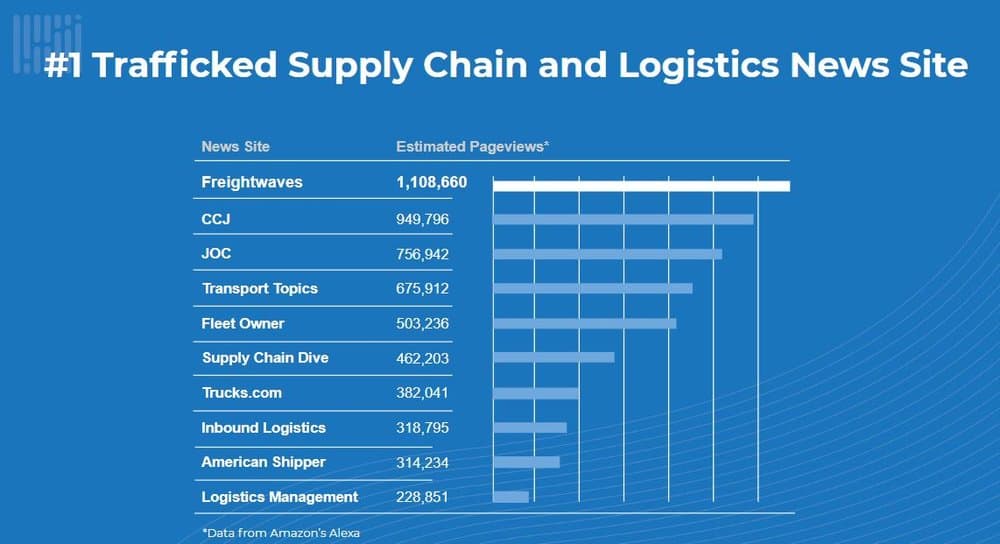The rise of FreightWaves in the pantheon of media focusing on trucking and transport has been significant enough that the Transportation & Marketing Sales Association annual meeting gave its founder an entire hour to talk about it.
Craig Fuller, who serves as FreightWaves’ CEO, discussed the reasons why its media presence started with a mostly one-contributor blog alongside its initiatives to launch a freight futures contract (set for later this year) and SONAR, a data analytics tool. But going forward, FreightWaves will need to be what he referred to as “community” for it to fully succeed.
Fuller, to help make his point, harkened back all of two weeks earlier, at the Transparency18 conference and “demo day,” when a lineup of presenters showed their technology solutions aimed at the freight market.
He contrasted what was shown that day with an easy “narrative” in which the entire brokerage industry was going to be quickly dispatched by digital alternatives. But what demo day showed, Fuller said, is that those disruptive technologies are going to need to prove themselves before a demanding audience.
“We wanted to see if this was real or not,” Fuller said. “Vaporware is incredibly easy to fake,” noting wryly that he had sold vaporware earlier in his career. “But if you have to show your technology within seven minutes to people who are far smarter about the business than you are, that’s a lot of pressure.”

Demo day helped show that the “narrative” of quick disintermediation “is not fair or right,” Fuller said. And what happened that day is “ultimately about how you build a community, and that’s what we’re all about.”
Besides, Fuller said, a lot of digital brokerage already is being conducted by traditional players such as C.H. Robinson or J.B. Hunt, and they are getting little to no credit for it. That sort of disconnect helped drive the formation of FreightWaves.
“We felt that the traditional news outlets covering the freight business were missing out on a big important part of it,” Fuller said. Coverage of the “narrative” that venture capital was going to disintermediate the freight space “was being written by outside media who didn’t understand the space.”
FreightWaves’ editorial model is more Reuters or Bloomberg than traditional trucking media. “FreightWaves has been described as if The Wall Street Journal and TechCrunch had a baby in the back of a semi, it would be FreightWaves,” Fuller said.
Data from Amazon’s Alexa that was cited by Fuller is reporting that FreightWaves’ number of unique page views is 1.1 million per month, with the next closest competitor in the space at about 950,000.

But the origin of the editorial initiative at FreightWaves, to go along with its freight futures and SONAR data products, came about because of the high cost of public relations support, according to Fuller. A PR veteran, after quoting healthy fees for his services, suggested that Fuller pursue a self-driven initiative. So veteran trucking journalist Brian Straight was hired to contribute content starting in 2017, and suddenly the page counts on the FreightWaves website proved themselves to be far beyond expectations.
Many of the story subjects had been written about previously, “but not by people who had dispatched loads,” Fuller said, referring to the extensive trucking background of the startup’s staff, calling that feature the “tribal knowledge.”
Social media also has been key in establishing FreightWaves’ presence, Fuller said. The company’s data shows that its Facebook page receives about 11 times as many as impressions as its next-closest competitor in the industry. “We’ve built a really strong social media presence, and anybody in the market should think about how that can segment your audience,” Fuller noted to an audience of many people focused on their respective company’s social media efforts.
Although the structure at FreightWaves is different, with business operations going on side-by-side with the editorial activities, Fuller insisted that there is a “real strict firewall” at FreightWaves, and editors are given free rein to write what they want.
The other key leg of the FreightWaves business plan is the Blockchain in Transport Alliance (BiTA), which Fuller described as the “largest transportation technology alliance in the world.”
Having so many players at the same table to discuss creating standards for blockchain applications in the trucking sector is a reversal of traditional past practice, where an “insular” culture led everyone to view each transaction as a “zero sum game,” Fuller said.
And it comes down to one key driving factor, Fuller said: “if we don’t set the standards, Silicon Valley will.”










